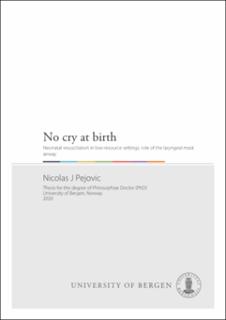No cry at birth : Neonatal resuscitation in low-resource settings: role of the laryngeal mask airway
Doctoral thesis
Permanent lenke
https://hdl.handle.net/1956/21575Utgivelsesdato
2020-03-27Metadata
Vis full innførselSamlinger
Sammendrag
Background: Approximately 2.5 million newborn infants died in the first month of life in 2019, despite the global rate being halved since 1990. The current newborn mortality rate in Sub-Saharan Africa is > 20 times higher than the average ratio of 1 in 600 found in high-resource countries. Intrapartum-related death or birth asphyxia is the third leading cause of under-5 mortality and contributes significantly to global long-term developmental disability. Effective ventilation has the potential to reduce 30% of these deaths. The laryngeal mask airway (LMA) is an airway tube that can be blindly inserted through the mouth of a non-breathing infant to form an airtight seal around the glottis. This device could improve neonatal resuscitation. Aim: To investigate whether midwives in low-resource settings could safely resuscitate newborns more effectively using LMA instead of a conventional facemask (FM). Methods: We conducted a preclinical manikin study and 2 randomized clinical trials in Uganda. Health workers involved in neonatal resuscitation were given brief training with LMA and FM. We recorded success rate and insertion times, leading to effective ventilation in the manikin. Participants rated the perceived efficiency of the devices using a 5-point scale. In the 2 clinical trials, midwives performing resuscitation after delivery of asphyxiated newborn infants were randomly assigned to ventilate with either LMA or FM. In the first trial, we collected data on ventilation time with a video monitor and heart rate (HR) with the NeoTap LS mHealth App. In the second trial, respiratory function was measured through a flow sensor, and HR data collected with a dry-electrode ECG. Results: In the preclinical trial, LMA was 100% successful on the first insertion. FM was significantly less effective in achieving effective positive pressure ventilation (PPV), and the failure rate at the first attempts was 28%. The perceived efficiency of the devices was superior for the LMA. In the first clinical trial, resuscitated infants started breathing on their own sooner in the LMA arm compared to FM. All resuscitations were effective in the LMA arm, and there were no side effects. In the second trial, mask leak (%) and tidal volume (ml/kg) were similar in both groups. The time needed to achieve heart rate >100 bpm in LMA was shorter than in the FM arm. There were no severe adverse events in either arm. Conclusion: LMA was more effective in establishing PPV in the manikin and user satisfaction was higher. LMA was more effective than FM in reducing the time to spontaneous breathing. LMA was associated with faster heart rate recovery compared to FM in newborns with bradycardia. Mask leaks and tidal volumes using LMA was similar to FMV. LMA seems to be a safe and effective device for newborn resuscitation in low-resource settings.
Består av
Paper I: Pejovic NJ, Trevisanuto D, Nankunda J, Tylleskär T. Pilot manikin study showed that a supraglottic airway device improved simulated neonatal ventilation in a low-resource setting. Acta Paediatr. 2016 Dec;105(12):1440-1443. The article is available in the main thesis. The article is also available at: https://doi.org/10.1111/apa.13565Paper II: Pejovic NJ, Trevisanuto D, Lubulwa C, Myrnerts Höök S, Cavallin F, Byamugisha J, Nankunda J, Tylleskär T. Neonatal resuscitation using a laryngeal mask airway: a randomized trial in Uganda. Arch Dis Child. 2018 Mar;103(3):255-260. The article is available in the main thesis. The article is also available at: https://doi.org/10.1136/archdischild-2017-312934
Paper III: Pejovic NJ, Cavallin F, Mpamize A, Lubulwa C, Myrnerts Höök S, Byamugisha J, Nankunda J, Tylleskär T, Trevisanuto D. Respiratory monitoring during newborn resuscitation using a laryngeal mask airway vs. a facial mask: a quasi-randomized trial. The article is not available in BORA.
Annex: Pejovic NJ, Myrnerts Höök S, Byamugisha J, Alfvén J, Lubulwa C, Cavallin F, Nankunda J, Ersdal H, Segafredo G, Blennow M, Trevisanuto D, Tylleskär T. Neonatal resuscitation using a supraglottic airway device for improved mortality and morbidity outcomes in a low-income country: study protocol for a randomized trial. Trials. 2019 Jul 19;20(1):444. The article is available at: http://hdl.handle.net/1956/21574
